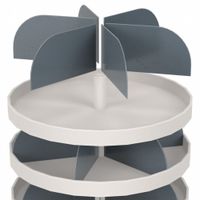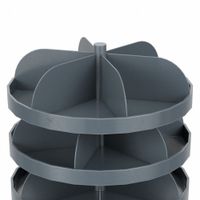Call +(254) 703 030 000 / 751 483 999 / 721 704 777
- Home
- Material Handling
- Storage Workspace
- Bin Compartmented Storage Units
- Revolving Storage Bins Accessories
.....Read More
Frequently Asked Questions
What are revolving storage bins used for?
Revolving storage bins are used for efficient organization, storage, and retrieval of items in various settings such as warehouses, workshops, retail environments, and manufacturing facilities. These bins are designed to rotate, providing easy access to stored items without the need to move the entire unit. This feature maximizes space utilization and enhances workflow efficiency.
In warehouses and industrial settings, revolving storage bins are often used to store small parts, tools, and components. They help in maintaining an organized inventory, reducing the time spent searching for items, and minimizing errors in picking processes. The bins can be labeled for easy identification, further streamlining operations.
In retail environments, revolving storage bins are used to display merchandise in a compact and accessible manner. They allow customers to view and select products easily, enhancing the shopping experience and potentially increasing sales. These bins are particularly useful for displaying small, high-turnover items such as accessories, snacks, or cosmetics.
In workshops and garages, revolving storage bins help in organizing tools and supplies, keeping the workspace tidy and efficient. They allow for quick access to frequently used items, improving productivity and reducing downtime.
Overall, revolving storage bins are versatile solutions that improve organization, accessibility, and space efficiency across various applications.
How do revolving storage bins work?
Revolving storage bins, also known as rotary bins or carousel storage systems, operate on a simple yet efficient mechanism designed to maximize space and improve accessibility. These systems consist of a series of shelves or bins mounted on a rotating track or carousel. The rotation can be manual or motorized, depending on the design and application.
The primary function of revolving storage bins is to bring stored items directly to the user, minimizing the need for excessive movement and reducing retrieval time. This is achieved through a vertical or horizontal rotation mechanism. In vertical carousels, the bins rotate vertically, similar to a Ferris wheel, while in horizontal carousels, they rotate around a central axis, akin to a merry-go-round.
Users can control the rotation through a control panel or interface, selecting the desired bin or shelf. In automated systems, the carousel can be integrated with inventory management software, allowing for precise tracking and retrieval of items. This automation enhances efficiency, reduces human error, and optimizes inventory management.
Revolving storage bins are commonly used in environments where space is limited, such as warehouses, manufacturing facilities, and retail settings. They are particularly beneficial for storing small to medium-sized items, providing high-density storage and easy access. The design also improves ergonomics by reducing the need for bending, reaching, or climbing, thus enhancing workplace safety.
Overall, revolving storage bins offer a compact, efficient, and user-friendly solution for organizing and accessing stored items, making them a valuable asset in various industrial and commercial applications.
What are the benefits of using revolving storage bins?
Revolving storage bins offer several benefits that enhance organization, efficiency, and accessibility in various settings:
1. **Space Optimization**: These bins maximize vertical space, allowing for more storage in a smaller footprint. This is particularly beneficial in areas with limited space.
2. **Improved Accessibility**: The rotating mechanism ensures that items are easily accessible without the need to move other items, reducing retrieval time and effort.
3. **Enhanced Organization**: Revolving bins facilitate better organization by allowing items to be sorted and stored in a systematic manner. This helps in quick identification and retrieval of items.
4. **Time Efficiency**: By minimizing the time spent searching for items, these bins increase productivity, especially in environments like warehouses or workshops where time is critical.
5. **Versatility**: They can be used to store a wide range of items, from small parts and tools to larger goods, making them suitable for various industries.
6. **Reduced Clutter**: By providing a designated space for each item, revolving bins help in maintaining a clutter-free environment, which can improve safety and workflow.
7. **Durability and Stability**: Often made from robust materials, these bins are designed to withstand heavy use and can support significant weight, ensuring longevity and reliability.
8. **Cost-Effectiveness**: By improving space utilization and efficiency, revolving storage bins can reduce the need for additional storage solutions, leading to cost savings.
9. **Aesthetic Appeal**: They offer a neat and organized appearance, which can enhance the overall look of a space, whether in a retail setting or a personal garage.
10. **Customization**: Many revolving storage systems can be customized with adjustable shelves or compartments to meet specific storage needs.
Overall, revolving storage bins are a practical solution for efficient storage management, offering both functional and economic advantages.
What materials are revolving storage bins made from?
Revolving storage bins are typically made from a variety of materials, each chosen for its specific properties to suit different applications and environments. Common materials include:
1. **Plastic**: Often used for its lightweight, durability, and resistance to moisture and chemicals. Types of plastic used include polyethylene and polypropylene, which are ideal for environments where corrosion resistance is important.
2. **Metal**: Steel and aluminum are frequently used for their strength and durability. Steel bins are often coated or galvanized to prevent rust, making them suitable for heavy-duty applications. Aluminum is lighter and resistant to corrosion, making it ideal for environments where weight is a concern.
3. **Wood**: Less common but used for aesthetic purposes or in environments where a natural look is desired. Wood bins are typically treated to resist moisture and pests.
4. **Wire Mesh**: Made from metal wires, these bins offer visibility and ventilation, making them suitable for storing items that need air circulation. They are often coated to prevent rust.
5. **Composite Materials**: These are combinations of materials like fiberglass or reinforced plastics, offering a balance of strength, weight, and resistance to environmental factors.
6. **Fabric**: Used in collapsible or flexible storage bins, often made from durable materials like canvas or polyester. These are lightweight and can be easily moved or stored when not in use.
Each material offers distinct advantages, and the choice depends on factors such as the intended use, environmental conditions, and budget.
Can revolving storage bins be customized with accessories?
Yes, revolving storage bins can be customized with a variety of accessories to enhance their functionality and adaptability to specific needs. These accessories can include dividers, which help in organizing and separating different items within the bins, making it easier to access and manage stored materials. Label holders can be added to provide clear identification of contents, improving efficiency in locating items.
Additionally, lids or covers can be customized to protect contents from dust or contamination, which is particularly useful in environments where cleanliness is crucial. Casters or wheels can be added to the base of the bins to enhance mobility, allowing for easy movement and repositioning within a workspace.
For added security, locking mechanisms can be integrated to protect valuable or sensitive items. Some revolving storage bins can also be fitted with adjustable shelves, allowing for the accommodation of items of varying sizes and optimizing the use of vertical space.
In industrial or commercial settings, bins can be customized with specific materials or finishes to withstand particular environmental conditions, such as high temperatures or exposure to chemicals. Ergonomic handles or grips can be added to facilitate easier handling and rotation of the bins.
Overall, the customization of revolving storage bins with these accessories allows for a tailored storage solution that meets the unique requirements of different users and applications, enhancing both organization and efficiency.
How much weight can revolving storage bins hold?
The weight capacity of revolving storage bins varies significantly based on their design, materials, and intended use. Generally, these bins are used in industrial, commercial, or residential settings, and their load capacity is determined by factors such as the construction material (metal, plastic, or composite), the size of the bin, and the strength of the rotating mechanism.
1. **Industrial Revolving Bins**: These are typically made from heavy-duty materials like steel or reinforced plastic and are designed to hold substantial weights. They can often support loads ranging from 200 to 1,000 pounds or more per shelf, depending on the specific model and manufacturer. These bins are used in warehouses and factories for storing heavy parts or tools.
2. **Commercial Revolving Bins**: Used in retail or office environments, these bins are usually constructed from lighter materials and have a moderate weight capacity. They might hold between 50 to 300 pounds per shelf. They are ideal for storing items like office supplies, retail products, or light equipment.
3. **Residential Revolving Bins**: Typically found in kitchens, garages, or closets, these bins are designed for lighter loads. They are often made from plastic or lightweight metal and can support around 20 to 100 pounds per shelf. They are suitable for storing food items, cleaning supplies, or small household tools.
When selecting a revolving storage bin, it is crucial to consider the manufacturer's specifications and guidelines to ensure safe usage. Overloading a bin can lead to mechanical failure or accidents. Always distribute weight evenly across the shelves to maintain balance and functionality.
Where can I purchase revolving storage bins?
You can purchase revolving storage bins from a variety of sources, including:
1. **Online Retailers**: Websites like Amazon, Wayfair, and Walmart offer a wide range of revolving storage bins in different sizes and materials. You can compare prices, read customer reviews, and often find deals or discounts.
2. **Home Improvement Stores**: Stores such as Home Depot and Lowe's carry revolving storage bins, especially in their storage and organization sections. You can check their websites for availability and even order online for in-store pickup.
3. **Office Supply Stores**: Staples and Office Depot often have revolving storage solutions suitable for office environments. These can be purchased in-store or online.
4. **Specialty Storage Retailers**: The Container Store specializes in storage solutions and offers a variety of revolving storage bins. They provide both in-store and online shopping options.
5. **Industrial Supply Stores**: Grainger and Uline offer revolving storage bins designed for industrial or commercial use. These are typically more robust and can be ordered online or through a catalog.
6. **Local Retailers**: Check local department stores or specialty shops that focus on home organization. They may have unique or locally made options.
7. **Second-Hand Marketplaces**: Websites like eBay, Craigslist, or Facebook Marketplace can have used revolving storage bins at a lower cost.
8. **Direct from Manufacturers**: Some manufacturers sell directly to consumers through their websites, offering a broader range of customization options.
9. **Wholesale Clubs**: Costco or Sam's Club may have bulk purchasing options for revolving storage bins, ideal for businesses or large households.
10. **Custom Solutions**: For specific needs, consider contacting a local carpenter or custom storage solution provider to design and build revolving storage bins tailored to your requirements.

